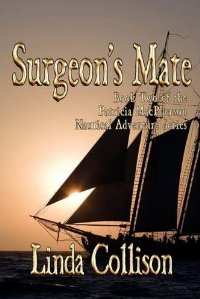
I’m delighted for Patricia MacPherson, my 18th-century cross-dressing protagonist, to be among those fictional ladies in the spotlight this week, as part of Helen Hollick‘s October blog tour celebrating female protagonists through the centuries. Blog tours are fun ways to be introduced to authors you might not otherwise be familiar with. Welcome aboard my blog, a Sea of Words; charting a course from imagination to publication. As you can tell from the title, the major focus of my blog is the process of writing.
I was thrilled when Helen invited me to participate because I’ve been at work for several years now on Leaving Havana, the third book in the Patricia MacPherson Nautical Adventure Series.
Patricia MacPherson came to me in the middle of the Pacific Ocean. She appeared in my imagination, insistent that I tell her story. It was the middle of the night while I was at the helm of the HM Bark Endeavour (yes! — I was taking my turn steering the famous replica ship!) on a passage from Vancouver to Hawaii in1999. My husband and I had joined the ship with a few dozen other middle-aged wannabe sailors, as “voyage crew” — temporary hands to help sail the old girl on a part of her journey around the world that year. When we signed on we agreed to stand our watch, climb aloft to make and furl sail, help clean and maintain the ship, and obey the captain and officers. For three weeks we essentially lived the lives of 18th century sailors, standing our watch, steering the ship, and scrambling up the ratlines and out on the foot rope beneath the yard arm high above the deck, to let loose or take in canvas. We took our turns at galley duty, we maintained the vessel, and when our watch was over we strung our hammocks from the deck head an slept, exhausted, until the ship’s bell roused us again. It was very much like a time machine back to life aboard an 18th century British sailing ship. I would later write an article published in Sailing Magazine about my experience, entitled Three Weeks Before the Mast.
But by the time I disembarked in Hawaii I also had the beginnings of a novel in my mind — a story about a young woman aboard an 18th century sailing ship — much like the ship I had just been a part of. The ship was my setting — I knew it intimately. Like me, my female protagonist would not be just a passenger. One thing I had discovered first hand was that women can do anything men can do, when it comes to sailing or maintaining a ship. Maybe there was more truth than I realized to those old 18th century British ballads and broadsheets about girls going to sea dressed as men.
Although the character Patricia, had made herself known to me, and although I knew the setting like the back of my hand, I had a lot of research to do — six years’ worth — before I had a finished manuscript. In that research I discovered many documented cases of girls who really did go to sea disguised as boys. In most cases they were only discovered while being treated for life-threatening battle wounds. Think of the many who might never have been caught!
My novel Star-Crossed was published by Knopf in the fall of 2006 as a Young Adult historical novel. In 2007 it was chosen by the New York Public Library to be among the Books for the Teen Age. I wrote the rough draft of a sequel, but Knopf wasn’t interested in a series; they had published it as a stand-alone. My agent declined. But Tom Grundner, founder of Fireship Press and Editor-in-Chief, wanted to acquire my series and in 2011 Surgeon’s Mate; book 2 of the Patricia MacPherson Nautical Adventure Series was published. In 2012 Fireship Press published a slightly revised Star-Crossed (now out of print) as Barbados Bound; book 1 of the Patricia MacPherson Nautical Adventure Series. Tom was enthusiastic about my books and we were discussing a third book when he died suddenly. My plans for the third book were abandoned for a time, as I felt I had lost not just an editor but a mentor.
Patricia has languished for a few years, seemingly lost at sea, while I’ve completed several other novels I had in the works. Tired of waiting to be rescued, she has managed to jury-rig a sail and find the wind to fill it. She insists I continue her story. I’m not sure I could have, had I not found a new mentor and several trustworthy writing “mates” who know nautical history and are supportive and encouraging of our efforts — Patricia’s and mine. I am very grateful for these writers — and for the readers who have taken the time to let me know how much they want to read more adventures of Patricia MacPherson. Unlike Star-Crossed, the version Knopf published , the Patricia MacPherson Nautical Adventure series are adult novels, not YA . 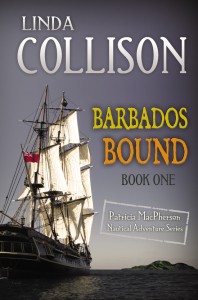
Barbados Bound (first published as Star-Crossed by Knopf in 2006 as a stand-alone YA historical novel.)
Portsmouth, England,1760. Patricia Kelley, the illegitimate daughter of a wealthy Barbadian sugarcane planter, falls from her imagined place in the world when her absent father unexpectedly dies. Raised in a Wiltshire boarding school sixteen-year-old Patricia embarks on a desperate crossing on a merchantman bound for Barbados, where she was born, in a brash attempt to claim an unlikely inheritance. Aboard a merchantman under contract with the British Navy to deliver gunpowder to the West Indian forts, young Patricia finds herself pulled between two worlds — and two identities — as she charts her own course for survival in the war-torn 18th century.
In writing Patricia MacPherson’s story I wanted to explore what it might have been like for a young woman in the eighteenth century to live, work and reinvent herself aboard a ship. Although it’s a work of fiction, I have attempted to maintain historical accuracy.
Eighteenth century merchantmen and British Naval ships did indeed carry women — wives, girlfriends, passengers, prostitutes, laundresses — even though the Admiralty had rules on the books prohibiting it. Children too, were commonly found aboard ships. Some were born on the passage and some went to sea at an early age for their livelihood.
According to numerous sources, some women really did enlist in the navy and army in male disguise. Several accounts tell of women who worked for months, and in some cases years, before being found out. These impostors carried out their duties, performed bravely in battle and were only discovered to be female after being wounded in the line of duty. (The artifice may have occurred more often than has been recorded, simply because some women may have successfully carried it off.)
Thought the work was hard and not without danger, a ship provided room and board, and a chance for adventure. In fact, it still does.
Surgeon’s Mate; Book 2.
It’s late October, 1762. After surviving the deadly siege of Havana, Patrick MacPherson and the rest of the ship’s company are looking forward to a well deserved liberty in New York. But what happens in that colonial town will change the surgeon’s mate’s life in ways she could never have imagined. Using a dead man’s identity, young Patricia Kelley MacPherson is making her way as Patrick MacPherson, surgeon’s mate aboard His Majesty’s frigate Richmond. She’s become adept at bleeding, blistering, and amputating limbs; but if her cover is blown, she’ll lose both her livelihood and her berth aboard the frigate. The ship’s gunner alone knows her secret – or does someone else aboard suspect that Patrick MacPherson is not the man he claims to be? Surgeon’s Mate, book two of the Patricia MacPherson Nautical Adventure Series, is a work of fiction inspired in part by the historical accounts of actual 17th and 18th century soldiers, sailors and marines who were in fact women. Included in this group were Christian Davies, Hannah Snell, Mary Lacy, Mary Anne Talbot, Deborah Sampson, to name but a few.
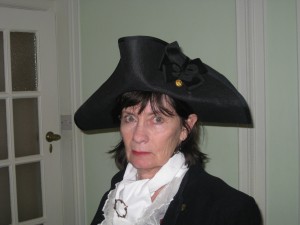
(Here’s a photo of me at the 2012 Historical Novel Society Conference costume party — cross-dressed as Patricia’s male persona, Patrick MacPherson.)
Leaving Havana; Book 3 of the Patricia MacPherson Nautical Adventure Series
In this work-in-progress Patricia continues her association with Yankee smugglers at great risk, and is reunited with three people from her past, making some rash decisions with enormous, life-changing consequences. Look for it to be released by Spring, 2016…

Now let me hand the microphone to Helen Hollick, an amazing historical novelist who writes in several different eras. If you are an historical novel aficionado, chances are, you already know this author — a force of nature, she is. I had the good fortune to be on a nautical historical panel with her at the 2012 Historical Novel Conference in London and since I have become acquainted with her and her work I’ve been greatly inspired by her writing process and her writing style — not to mention her energy and willingness to encourage and promote historical fiction by emerging writers.

Helen lives on a thirteen-acre farm in Devon, England. Born in London, Helen wrote pony stories as a teenager, moved to science-fiction and fantasy, and then discovered historical fiction. Published for over twenty years with her Arthurian Trilogy, and the 1066 era, she became a ‘USA Today’ bestseller with Forever Queen. She also writes the Sea Witch Voyages, very engaging, somewhat salty, pirate-based fantasy adventures. The ocean connects us all, and that’s how I first found Helen. As a supporter of Indie Authors Helen Hollick is Managing Editor for the Historical Novel Society Indie Reviews, and inaugurated the HNS Indie Award. Please check out her blog post today, Let us talk of many things
As for her ladies — her female protagonists and supporting characters – every sea captain needs a woman to come home to, but Captain Jesamiah Acorne (ex-pirate) has three to choose from: Tiola ( a midwife and a white witch) ‘Cesca, an English woman with a Spanish name (a spy) and Alicia… well, all Alicia wants is Jesamiah’s money…
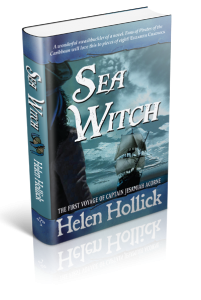
A rollicking nautical adventure!
Now, let me reacquaint you with Anna Belfrage.
Anna is a delightful author I featured here on my Sea of Words blog last year. (See, Anna Belfrage talks of time travel and other writing secrets)

Had Anna been allowed to choose, she’d have become a professional time-traveller. As such a profession does not exists, she settled for second best and became a financial professional with two absorbing interests, namely history and writing.
Presently, Anna is hard at work with The King’s Greatest Enemy, a series set in the 1320s featuring Adam de Guirande, his wife Kit, and their adventures and misfortunes in connection with Roger Mortimer’s rise to power. When Anna is not stuck in the 14th century, chances are she’ll be visiting in the 17th century, more specifically with Alex and Matthew Graham, the protagonists of the acclaimed The Graham Saga. This series is the story of two people who should never have met – not when she was born three centuries after him.
Meet Anna’s ‘lady’…. She was blackmailed into marrying an unknown knight. She hadn’t expected having to save his life as well…
visit Anna and – and a chance to win TWO of Anna’s books! Annabelfrage.wordpress.com

We are historical fiction writers shining the light on our female protagonists; thank you for your attention!
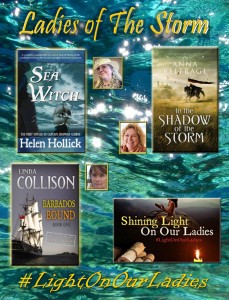
If you’ve enjoyed our posts please share and tweet #LightOnOurLadies. We appreciate your interest! In case you came late to the party, here’s what you missed:
The first three weeks of the #LightOnOurLadies tour:
6th October: Helen Hollick with Pat Bracewell and Inge Borg

13th October: Helen Hollick with Regina Jeffers, Elizabeth Revill and Diana Wilder

20th October : Helen Hollick with Alison Morton and Sophie Perinot
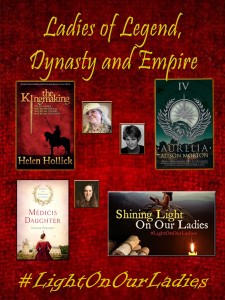
Keep that spotlight shining, ladies!
